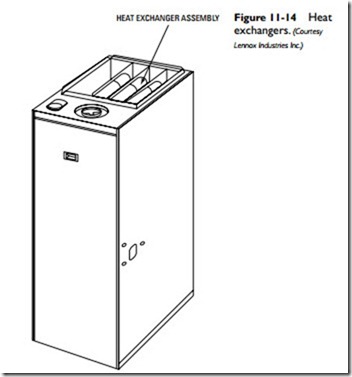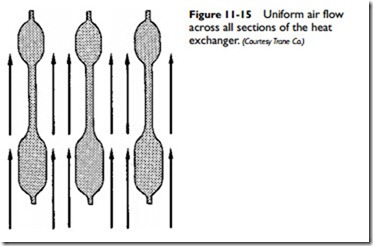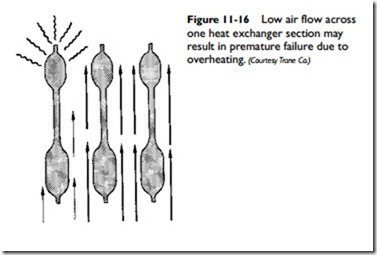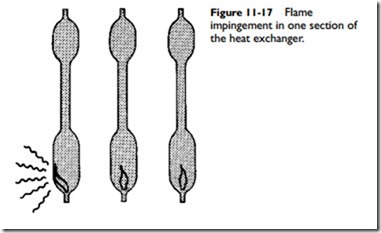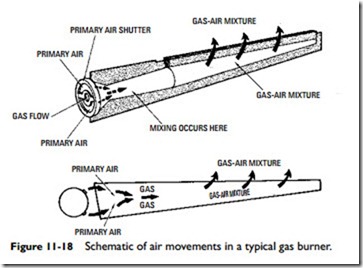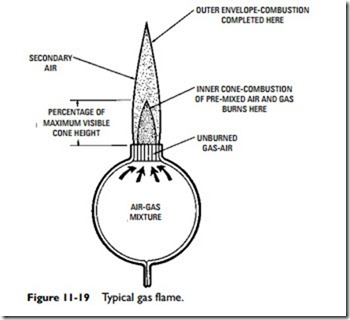Heat Exchanger
A traditional standing-pilot gas furnace has a burner compartment containing the gas burner and pilot. The gas and air necessary for combustion are mixed in the venturi or mixing tube prior to ignition.
This mixture is then ignited by the pilot flame as it leaves the burner. The burner flame is encased in a combustion chamber or firebox located directly below the furnace heat exchanger. The heat of the combustion process is transferred to the metal walls of the heat exchanger and then to the air rising through it (Figure 11-14).
The air flowing through a heat exchanger is subject to temperatures that frequently approach the 700 to 800°F range. Because of these high temperatures, the airflow must be uniform across all sections of the heat exchanger (as shown in Figure 11-15) and must move at a sufficient rate of speed to keep these temperatures from building any higher. A low volume of air flowing across one section of the heat exchanger will result in overheating and the failure of the entire heat exchanger assembly (Figure 11-16).
Overheating can also be caused by a portion of the gas flame impinging on the inner surface of the heat exchanger (Figure 11-17). This results in the generation of extremely high temperatures. Under normal operating conditions, the gas flame should be directed upward through the center of each section.
Another cause of heat exchanger failure is overfiring. This con- dition is usually traced to an excessively high manifold pressure or
If the heat exchanger becomes so covered with soot, carbon deposits, and other contaminants that it reduces the operating efficiency of the furnace, it should be thoroughly cleaned. Gaining access to the heat exchanger on some furnaces is not easy because it may require removing the burners and manifold assembly, vent connector, draft hood (diverter), and flue baffles. For this type of furnace, you are advised to call a local service repairman if you want to clean the heat exchanger. Many furnace manufacturers now provide convenient and accessible cleanout openings to make this maintenance chore easier.
Gas Burners
Gas burners and gas burner assemblies are designed to provide the proper mixture of gas and air for combustion purposes. The gas burners used in residential heating installations operate primarily on the same principle as the Bunsen burner. See Chapter 2, “Gas Burners” in Volume 2.
Gas furnaces require both primary and secondary air for the combustion process. The gas passes through the small orifice in the mixer head, which is shaped to produce a straight-flowing jet moving at high velocity (Figure 11-18). As the gas stream enters the throat of the mixing tube, it tends to spread and induce air in through the opening of the adjustable shutter. This is the primary air, which mixes with the gas before the air-gas mixture is forced
through the burner ports (Figure 11-18). The pressure in the gas stream forces the mixture through the mixing tube into the burner manifold casting, from which it issues through ports where additional air must be added to the flame to complete combustion. This secondary air supply flows into the heat exchanger and around the burner. Its function is to mix with unburned gas in the heat exchanger in order to complete the combustion process.
The primary air is admitted at a ration of about five parts primary air to one part gas for manufactured gas, and at a 10:1 ratio for natural gas. These ratios are generally used as theoretical values of air for purposes of complete combustion. Most burners used in gas-fired furnaces operate efficiently on 40 to 60 percent of the the- oretical value. Primary air is regulated by means of an adjustable shutter. When burning natural gas, the air adjustment is generally made to secure as blue a flame as possible. Burner manufacturers provide a number of different ways to field adjust primary air. For example, shutters for primary air control are part of the main burners. Factory adjusted, angled orifices are also used on some burners.
The secondary air is drawn into the burner by natural draft. No provision is made by manufacturers to field adjust secondary air. Secondary air is controlled primarily by the design of the flue restrictors and draft diverter. The general configurations of the heat exchanger and burners are also important factors in secondary air
control. Excess secondary air constitutes a loss and should be reduced to a proper minimum (usually not less than 25 to 35 percent).
As shown in Figure 11-19, a typical gas flame consists of a well- defined inner cone surrounded by an outer envelope. Combustion of the primary air and gas mixture occurs along the outer surface of the inner cone. Any unburned gases combine with the secondary air and complete the combustion process in the outer envelope of the flame.
As Figure 11-19 illustrates, the major portion of the inner cone consists of an unburned air-gas mixture. It is along the outer sur- face of the inner cone that combustion takes place. The height of the inner cone can be reduced by increasing the amount of primary air contained in the air-gas mixture. The extra oxygen increases the burning rate, which causes the inner cone to decrease in size.
A burner is generally considered to be properly adjusted when the height of the inner cone is approximately 70 percent of the maximum visible cone height. The gas should flow out of the burner ports fast enough so that the flame cannot travel or flash back into the burner head. The velocity must not be so high that it blows the flame away from the port(s).
Related posts:
Incoming search terms:
- cylinder cooling and heat for furnace burner image
- requirment for burners heat
- HVAC burner
- metal heat change for gas burners
- gas furnace burner tubes
- parts of a heat exchanger residential primary and secondary air mix
- primary and secondary air in furnaces
- primary burner and secondary burner in furnaces
- a furnace with a horizontal heat exchanger and a propeller fan for moving air through the heat exchanger?
- replacement of burners and heat exchangers in a boiler
- Steam furnace manufactures
- trouble free unless the 339777
- what is a secondary in gas furnace
- how to clean chemical tank heat exchanger attached to maxonn 2 million btu burner
- High Pressure Coil-wound Heat Exchanger manufactures
- am-0008913 gas burner for furnace
- carrier gas pack heat exchanger two burner
- Domestic Furnaces manufacturers
- furnace burner heat exchanger
- Gas Burners
- heat and control 950000 byt natural gas buner
- heat exchanger for gas burners
- heat exchanger for gas furnace
- Heat Exchanger Tubes manufactures
- heat exchangerwith gas burner
- what is the part of the burner that increases air velocity to induce the primary air
